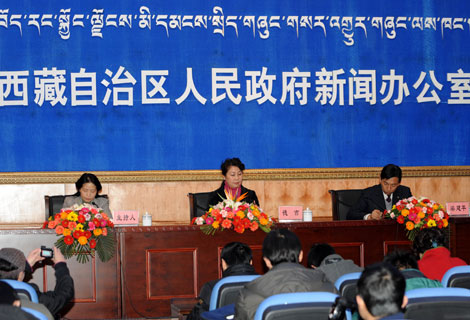The process of Tibet's Democratic Reform led by the Communist Party of China since 1959 has "profoundly changed the fate of the Tibetan people," according to a white paper released by the State Council's Information Office Monday.
The paper, titled "Fifty Years of Democratic Reform in Tibet" tells how the Chinese government liberated a million Tibetan serfs and slaves from the feudal serfdom system of oppression and exploitation. China's influence made Tibetans masters of their own destiny through measures including land reform and theocracy abolishment.
|
A press conference is held in Lhasa, capital of southwest China's Tibet Autonomous Region, March 2, 2009, for the white paper titled "Fifty Years of Democratic Reform in Tibet" released by the Information Office of the State Council, or China's Cabinet. (Xinhua Photo) |
"Carrying out democratic reform and abolishing the feudal serfdom of theocracy was an inevitable requirement for social progress. It was a major task of the people's democratic revolution led by the Communist Party of China, and was the only solution for social development in Tibet," according to the paper.
The peaceful liberation of Tibet on May 23, 1951, when the "17-Article Agreement" was signed in Beijing, "enabled Tibet to shake off the trammels imposed by imperialist aggressors, brought to an end to the long-term isolation of Tibet and stagnancy of its social development," it said.
The paper listed some achievements made during the democratic reform:
Abolishing the oppression and exploitation of feudal serfdom system, liberating a million serfs and slaves
After the quelling of the armed rebellion in 1959, the central government immediately dissolved the Kasha regime and its armed forces, courts and prisons, which had oppressed the Tibetans for hundreds of years.
The central government also kicked off campaigns in rural, pastoral areas and monasteries aimed to abolish rebellion, corvee labor and slavery, cut land rent and loan interests and cancel feudal privileges.
After the democratic reform, lives and personal freedom were protected and safeguarded by the Chinese Constitution and law.
"They no longer suffer from the serf-owners' political oppression, forced labor and inhuman treatment, as well as heavy corvee taxes and usurious exploitation." according to the paper.
Implementing land reform, abolishing the feudal land ownership, making serfs and slaves masters of the land
In September 1959, the Preparatory Committee of the Tibet Autonomous Region passed the "Decision on Abolishing Feudal Land Ownership System and Implementing Farmers' Land Ownership."
Afterward, farmland and other means of production originally occupied by serf-owners involved in the armed rebellion were confiscated and distributed to landless serfs and slaves. The land and other means of production of serf-owners who had not participated in the rebellion were redeemed by the state and then distributed to the serfs and slaves.
The central government then spent 45 million yuan on the redemption of 900,000 mu (60,000 ha) of land and more than 820,000heads of livestock from more than 1,300 households of serf-owners and agents who had not participated in the rebellion, according to statistics in the paper.
More than 2.8 million mu of land was confiscated or redeemed from serf-owners, and was distributed to 800,000 former serfs or slaves of 200,000 households. Each of the former serfs and slaves received about 3.5 mu of land.
When the land reform was completed in 1960, the total grain output for Tibet was 12.6 percent higher than that in 1959 and 17.5 percent higher than in 1958, the year before the land reform. The total number of livestock was 10 percent more than that in 1959.
During the democratic reform, Tibet's first supply and marketing cooperative, first rural credit cooperative, first private primary school, first night school, first literacy class, first film projection team and first modern medical organization were established.
In 1960, Ngachen Hydroelectric Station was completed and put into use, bringing electric lighting for the first time to the citizens of Lhasa.
Roads built in Tibet from 1959 and 1969 totaled 12,500 km, with a coverage of more than 90 percent of the counties in the region, according to the paper.


